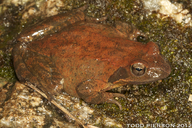|
Rana huanrensis Fei, Ye and Huang, 1991
Huanren Frog, Korean Stream Brown Frog Subgenus: Rana | family: Ranidae genus: Rana |
 © 2012 Todd Pierson (1 of 3)
|
|
|
|
Description Dorsal coloration is greyish, brown, brown-olive, or olive for Rana huanrensis . Dark spots may or may not be present (Kuzmin 1999). The male ventral color pattern is yellowish-gray, with tiny black dots covering the throat and chest. Females also have the tiny black dots covering the throat and chest, and during breeding season, the female ventral color is yellowish-green (Kim et al. 2002). In contrast, the sympatric species R. dybowskii can be distinguished by a milky white venter in males and red throat and chest patches in females (Kim et al. 2002). Distribution and Habitat Country distribution from AmphibiaWeb's database: China, Korea, Democratic People's Republic of, Korea, Republic of
Republic of Korea: Rana huanrensis lives in valleys in high montane regions, above 500 m in elevation (Yang et al. 2000). Life History, Abundance, Activity, and Special Behaviors Trends and Threats Relation to Humans Possible reasons for amphibian decline General habitat alteration and loss Comments Those literate in Chinese can find more information at the Sichuan Journal of Zoology. Those literate in Korean can find more information at DAPTF.
References
Dubois, A., Crombie, R. I., and Glaw, F. (2005). ''Recent amphibians: generic and infrageneric taxonomic additions (1981-2002).'' Alytes, 1.2(23), 25-69. IUCN, Conservation International, and NatureServe. (2006). Global Amphibian Assessment: Rana huanrenensis. [Internet]. www.globalamphibians.org. Accessed on 26 September 2007. Kim, J., Min, M., Yang, S., and Matsui, M. (2002). ''Genetic relationships among Korean brown frog species (Anura, Ranidae) with special reference to evolutionary divergences between two allied species Rana dybowskii and R. huanrenensis.'' Zoological Science, 19, 369-382. Kuzmin, S. L. (1999). The Amphibians of the Former Soviet Union. Pensoft, Sofia-Moscow. Liu, M., Liu, Y., and Li, J. (2004). ''Reproductive habits of Rana huanrenensis.'' Sichuan Journal of Zoology, 23(3), 183-184. Yang, S., Kim, J., Min, M., Suh, J., Kang, Y., Matsui, M., and Fei, L. (2000). ''First record of a Brown Frog Rana huanrenensis (Family Ranidae) from Korea.'' Korean Journal of Biological Science, 4, 45-50. Originally submitted by: Christin Hong (first posted 2007-10-10) Edited by: Kellie Whittaker (2011-02-15) Species Account Citation: AmphibiaWeb 2011 Rana huanrensis: Huanren Frog <https://amphibiaweb.org/species/5055> University of California, Berkeley, CA, USA. Accessed Nov 4, 2024.
Feedback or comments about this page.
Citation: AmphibiaWeb. 2024. <https://amphibiaweb.org> University of California, Berkeley, CA, USA. Accessed 4 Nov 2024. AmphibiaWeb's policy on data use. |





 Map of Life
Map of Life